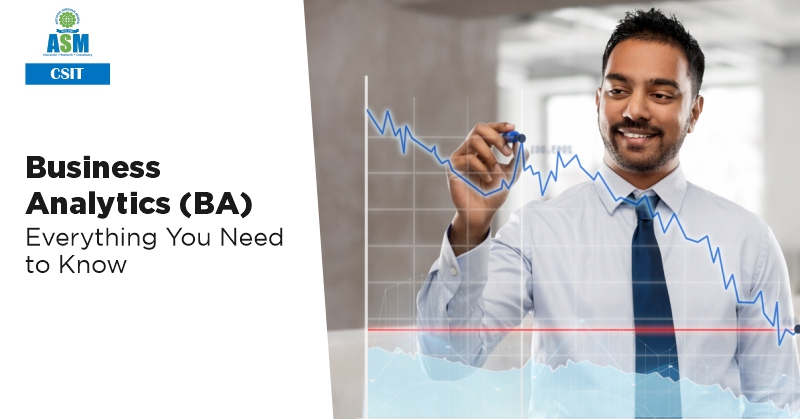Business Analytics (BA): Everything You Need to Know

Business Analytics: Overview
Business Analytics (BA) is analyzing different kinds of data with the help of statistics. It involves studying performances in the past and what should be the way ahead to attain the goals and desired numbers. This process involves using quantitative methods.
BA relies heavily on Big Data. It takes the help of predictive models to tell businesses how to optimize their resources and processes. This is not the same as Business Intelligence as the latter is concerned more with the collection of business data. Business Analytics is the actual processing of that data.
A business analyst will tell you why your company has derived those numbers and what needs to be done to either improve the performance or reach the desired numbers. In this blog, we will examine how Business Analytics works, the tools used in the process, the benefits and the scope in the future.
Business Analytics: How Does it Work
Business analytics makes use of a combination of applied mathematics and computer science to arrive at the correct marketing strategies. The results are then utilized in making or reworking HR policies, sales strategies, financial planning and product pricing. Broadly, BA relies on a combination of analytics methods and statistical methods.
The analytics methods can be further broken down into the following types:
Descriptive: This helps to describe or summarize data using measures of central tendency and dispersion.
Predictive: Data is analyzed to determine patterns and make predictions about future outcomes. The methods involved in this are Data Mining, Statistical Modelling and Machine Learning.
Prescriptive: After understanding ‘what happened’ and ‘what will happen’, this part of the analysis will tell you ‘what should happen’.
The statistical methods used in BA involve the following:
Sampling: A small set of observations is taken from a large population.
Correlation: The closeness of the relationship between two or more variables is studied.
Regression: This is a statistical technique used to predict the value of future outcomes. It helps in forecasting data and time-series analysis.
Graphical: In this method, the data is presented in the form of graphs and diagrams. Together they make the look convincing and appealing.
Business analytics: Components
Business Analytics works on a combination of factors. The knowledge of these components is essential to decide if this is going to be your career path. Let us first take a look at how a business analyst thinks. The first step is to identify the problem areas and the scope of improvement. This is usually done by retracing the steps involved in the production and marketing of a product or a service. It is a useful process to identify the pain points in a process.
The next part is to understand what kind of data is needed to arrive at the solutions. The source of the data, the type of data and the format in which it can be used have to be identified. The business analyst must verify this information. The collected data is then analyzed as per the areas of improvement.
Let us now look at the components of Business Analytics separately:
Objective: This is the first step and it is crucial for translating the business objectives into the objective of the analytics and thereby arrive at the data requirements.
Data aggregation: It is the process of collecting data in a centralized location. The data is taken from this pool and processed depending on the business requirement. The format of the data can also be changed at this stage to make it suitable for the tool being used for the analysis.
Data cleaning: Raw data is most often not suitable for analysis. It also needs to be compatible with the streams of study involved – mathematics, statistics and computer programming. Sometimes, the data is also resampled to remove duplication etc.
Analytical methodology: This is an essential component required to understand the method that the analysts will use to achieve their end goal. The knowledge of various procedures, methods and algorithms is essential at this point and this is where the business analyst plays a key role.
Evaluation & Validation: The next step is to evaluate the results. Simulation techniques are deployed at this stage as this delivers reliable results. The business analyst needs to use certain techniques to be able to know what went wrong and how to use the data to suit their needs.
Reporting & Data Visualization: Business analysts need to present their results in a visually effective way. This is why data visualization is a key component. The report is prepared in the form of tables and bullet points. Analysts often use innovative methods to present the data points in a storytelling method to the company heads as they further deliberate on these points in the decision-making stages.
Business Analytics: Types
Business Analytics can be utilized in multiple ways. It has different types and each of them has distinct utilization. Therefore, it becomes imperative for an analyst to know when and where a particular type is to be used.
The differentiation is based on the purpose of the analysis, the tools used and the kind of incidents where the type was used.
The four different types are as follows:
1. Descriptive – This particular type uses summary statistics on collected data to understand or describe what happened with a particular process or business model. For instance, the number of customers reached and how many have reacted positively to that particular initiative or campaign.
2. Diagnostic – The descriptive report provides data for the diagnostic stage so that the reason for the ‘what happened’ can be found. It deals with all the main reasons. To continue with the previous example, this stage will deal with the main reasons for the customer dissatisfaction and who are likely to behave the same way in the future.
3. Predictive – This mode is used to predict what could happen. In this stage, statistical or machine learning is used to predict what could happen. So, in this stage, the business house can predict the number of products they would need henceforth.
4. Prescriptive – Business analysts need to use the optimization machine and deep learning tools to determine what needs to be done now. In the case of the prescriptive methods for the company, the analyst is likely to suggest supply chain optimization, YouTube suggestions, ChatBots and digital assistants.
Tools of Business Analytics
A Business Analyst needs to assess data to come up with the required conclusions or solutions. To achieve a certain number of tools can be deployed mostly depending on the kind of situation. In certain cases, various tools are put to use at the same time but the analyst needs to know how to use them in harmony.
These tools are mostly needed to source data or create predictive models. They depend on the specialization for which they are being used and this is the reason why there is a wide range of tools. Let us look at these tools in detail:
1.SQL: This tool allows the analyst to filter out data from a large database and also split them into subsets. This helps in creating the required models with the least wastage of time. Structured Query Language (SQL) is compatible with other tools like OmniSci and Zeppelin.
2. PowerBI: This tool is very handy when it comes to visualization. It helps in quickly creating graphs that are even complex and detailed. This is a great aid in making a report impactful. Users say that this tool doesn’t ask for a lot of data to create the desired output.
3. Birt: It is one of the tools that is used to create graphs and dashboards. One of the disadvantages of this tool is that it is complex to a certain extent and the users need to have a certain amount of knowledge of Java.
4. Python: This is one of the most common tools and it is also popular for a reason. It comes in handy for various purposes, from cleaning up the data to developing various kinds of models. This tool also helps in creating reports and for visualizing results. The user is, however, free to use other dedicated visualization tools.
5. R: Analysts use this tool to perform descriptive and inferential statistics. Compared to python it is a bit trickier but once a user gets used to it, R can be certainly helpful and has a large community base of users.
6. MS Excel: One of the most basic tools that we all know but it does help a great deal while doing analytical work with data. This is used at the very end of the analysis as an MS Excel sheet can be a great way to present insights in a compact and self-explanatory form. The final output is more often than not in the form of an Excel document.
Importance of Business Analytics
Business Analytics plays a very important role in the workings of the industry. It helps businesses get a good overview of the processes and outcomes. It helps us understand why certain results were achieved and why some decisions proved to be failures. We can look into the importance of BA in some detail now.
- Companies that follow data more closely come up with better performances. Insights gained through business analytics help them arrive at better decisions.
- It offers support to businesses with real-time responses.
- The one obvious gain is that Business Analytics increases efficiency.
- Finally, it saves companies from having to take risks. Business analysts chalk out plans in detail and encourage the processes to be followed accordingly. Since BA has delivered encouraging results, managements are now comfortable about sticking to this style of working.
Business Analytics: Uses & Application
Business Analytics helps an establishment to recognize a business problem and restructure it to suit the needs of the moment. It helps in utilizing data, irrespective of the size, in an analytical way. This coupled with logical analysis can help businesses to make wise decisions.
We can take a look at some of the common applications of Business Analytics.
1. Agriculture Business Analytics: A business analyst can create predictive models for profitable crop production keeping in mind factors like the monsoon, floods, wind direction and crop loss.
2. Stock marketing: Business analysts study the stock market in terms of an organization’s performance, price fluctuations and other trends. They advise companies based on these observations about their future investments and earnings.
3. Manufacturing Industry: It is important to analyze the demand and supply trends of a product. The supplier and the product management team are updated according to this information. Business analysts use this information to segregate customer preferences. This helps in improving the marketing and advertising front.
4. Managing Finances: The study of data helps analysts identify the scope or presence of loopholes and mismanagement in a company’s finances. The analyst also flags off the presence of defaulters and frauds that are detrimental to the progress of businesses.
Business Analytics in Real-Time
The real-time analysis of data involves preparing and measuring data as soon as it is generated. Hence, the insights and interpretations are made available immediately. This helps businesses to take necessary action on time.
The benefits of real-time analytics include higher customer satisfaction, timely detection of frauds, targeting with discounts and offers at the right time. Let us look at two examples of how real-time BA can greatly benefit businesses.
1) A soft drink giant used real-time business analytics to pick up all mentions of their brand name on social media. It also started keeping a track of any photographs with their cola bottle being uploaded on networking platforms. This is the fastest form of targeted advertising and real-time BA plays a very important role in the same.
2) Netflix uses real-time data to give recommendations to its users. The suggestions based on previously-viewed programs have been made possible due to real-time data analysis. According to reports, this mechanism drives 80% of its content streaming.
Future Scope of Business Analytics
The scope of business analytics is bright because of the role of big data. Software giants like IBM and Cognizant are coming up with new ways to utilize business analytics in the best possible way.
Acknowledging this need, educational institutes are coming up with programs in business analytics that will enable students to pass out as business analysts of the future. According to industrial reports, AI chatbots will be handling 15% of customer interactions by the end of this year.
Business Analytics Vs. Business Intelligence
A comparison of business intelligence (BI) and business analytics (BA) requires us to first understand what each of these means or constitutes. Business Intelligence is the process of analyzing existing business data and using the results to improve or modify business processes. This is essential for successful business planning.
Meanwhile, Business Intelligence is the process of formulating strategies and technologies needed to analyze business data. Hence, while BI involves analysis of the past and present, BA deals with past data to manage the current business. BI is needed for the smooth functioning of the current business operations and BA is utilized to change business operations and improve productivity.
The tools used for both are also different. BI and BA have different applications and their methodologies are also different.
How To Start Career in Business Analytics
Any business analyst aspirant needs to be equipped with the necessary knowledge to execute the basic functions. Therefore, a relevant degree in the field is the first requirement. A business background or knowledge of IT is an advantage.
To begin with, after graduation you can enroll for a degree in computer science or business management. Thereafter, you can pursue a Master’s degree in the same. There are also various certificate courses that one can complete to upgrade your resume. This area of business requires people with analytical skills who can operate in diverse and fast-changing environments. Any work experience through internships or otherwise also give the candidate an edge in this competitive job market.
A business analyst also needs to know certain types of software and programming languages. The ability to communicate well, work in a team and leadership qualities go a long way in making the business analyst a valuable resource.
Summary
With technology making advancements by the day, the scope for businesses to make use of innovations has increased. This has also increased the importance of business analysts. BA makes it possible for organizations to address drawbacks and improve work quality with limited delay. The new normal or the post-pandemic working patterns require businesses to come up with more smart ways to attract customers.
The bright job prospects of this field of study have made this qualification a big favorite among tech students. A Business Analysis degree assures a high-paying job too and paves the way for a bright career. This is a fast-developing field and is bound to grow in leaps and bounds.


